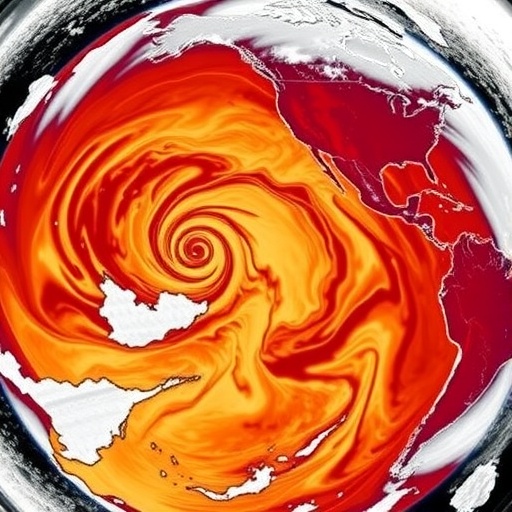A groundbreaking study recently published in Nature Communications unveils a transformative shift in the behavior of the El Niño-Southern Oscillation (ENSO), driven by escalating greenhouse gas emissions and global warming. ENSO, known for its profound influence on global climate variability, is anticipated to undergo a rapid intensification and increased regularity within the next few decades, a revelation that carries far-reaching implications for global weather systems and ecosystems.
Researchers from a consortium spanning South Korea, the United States, Germany, and Ireland employed state-of-the-art, high-resolution climate models to simulate future ENSO scenarios. These simulations predict a fundamental change from the historically irregular cycles of El Niño and La Niña to highly periodic oscillations marked by amplified sea surface temperature (SST) fluctuations across the tropical Pacific Ocean. The tropical Pacific, a crucible for global climate interactions, is thus poised to enter an unprecedented state of heightened variability driven by warming oceans and atmosphere.
At the heart of this climatic evolution is a tipping point in the coupled ocean-atmosphere system of the tropical Pacific. As the planet warms, air-sea interactions intensify, enhancing the feedback mechanisms that underpin ENSO dynamics. According to Prof. Malte F. Stuecker, Director of the International Pacific Research Center at the University of Hawaiʻi at Mānoa and lead author of the study, this shift signifies a transition “from stable to unstable oscillatory behavior,” a phenomenon now convincingly demonstrated within complex climate modeling frameworks for the first time.
One of the pivotal outcomes of this transition is the synchronization of ENSO with other major climate variability modes such as the North Atlantic Oscillation (NAO), the Indian Ocean Dipole (IOD), and the Tropical North Atlantic (TNA) mode. These distinct but interconnected oscillatory phenomena begin to resonate with each other in a manner akin to coupled pendulums aligning their rhythms. This emergent resonance amplifies climate variability on hemispheric and even global scales, triggering more severe and predictable fluctuations in temperature and precipitation patterns.
The practical repercussions of such synchronization are profound. Regions traditionally influenced by ENSO events, including Southern California and the Iberian Peninsula, may experience intensified swings in rainfall, increasing the likelihood of sudden hydroclimatic shifts often described as “whiplash” effects. These abrupt transitions between drought and flood conditions threaten to stress water resources, disrupt agriculture, and challenge existing infrastructural resilience.
These findings arise from advanced integrations of the Alfred Wegener Institute Climate Model (AWI-CM3), which boasts atmospheric resolutions of approximately 31 kilometers alongside ocean resolution scales of 4 to 25 kilometers. This spatial fidelity permits a more precise simulation of tropical Pacific dynamics and air-sea coupling mechanisms under future high-greenhouse-gas emission trajectories (RCP8.5 or equivalent). Model outputs were cross-validated with observational datasets and outputs from complementary climate models, reinforcing confidence in the projections.
Moreover, the intensification of ENSO and its synchronization with other climate modes offer a silver lining: the prospect of improved seasonal forecasting skill. A more regular ENSO cycle can potentially enhance predictability, enabling earlier and more reliable climate impact warnings. However, this increased predictability accompanies an escalation in event severity, demanding more robust adaptation policies and disaster preparedness frameworks globally.
Beyond the equatorial Pacific, the study underscores the interconnectedness of global climate systems. Alterations in ENSO’s behavior are expected to propagate far beyond the tropics, influencing climate variability over distant regions such as Europe through teleconnections modulated by synchronized oscillatory modes. Such systemic feedbacks highlight the intricate dependency of regional climates on large-scale atmospheric and oceanic dynamics.
The study’s significance further extends to its methodological innovation. Utilizing fine-scale climate models on the Aleph supercomputer at the Institute for Basic Science’s Center for Climate Physics in South Korea, the researchers achieved simulation resolutions of up to 9 kilometers and even 4 kilometers in recent runs. Such computational resolution allows for unprecedented detail in modeling mesoscale ocean features, atmospheric circulations, and their coupled feedbacks, thereby capturing ENSO dynamics with enhanced realism.
The urgency of these findings is heightened by the projected timeline: an abrupt transition in ENSO’s oscillatory characteristics is likely within the next 30 to 40 years. This rapid timescale challenges current adaptation strategies and underscores the need for accelerated research into climate resilience mechanisms. The cascading effects on ecosystems, agriculture, hydrology, and societal infrastructure warrant immediate attention from policymakers, scientists, and the broader public.
In conclusion, this study marks a pivotal advance in our understanding of climate variability under anthropogenic forcing. By illuminating a potential global synchronization of climate modes driven by a rapidly intensifying ENSO, it paints a complex yet vital portrait of our climate future. The interwoven amplification and regularization of climatic oscillations offer both opportunities for improved predictability and significant challenges for managing enhanced climate extremes. As such, this work provides a clarion call for integrated, multidisciplinary approaches to climate science and adaptation policy in the 21st century.
Subject of Research: Climate variability and El Niño-Southern Oscillation dynamics under global warming.
Article Title: Global climate mode resonance due to rapidly intensifying El Niño-Southern Oscillation.
News Publication Date: October 16, 2025.
Web References:
https://dx.doi.org/10.1038/s41467-025-64619-0
Image Credits: Institute for Basic Science
Keywords: Climate variability, El Niño, La Niña, Climate systems, Climate data, Climate change, Climatology, Earth sciences, Physical sciences, Environmental sciences, Climate modeling, Ecological modeling, Applied ecology




